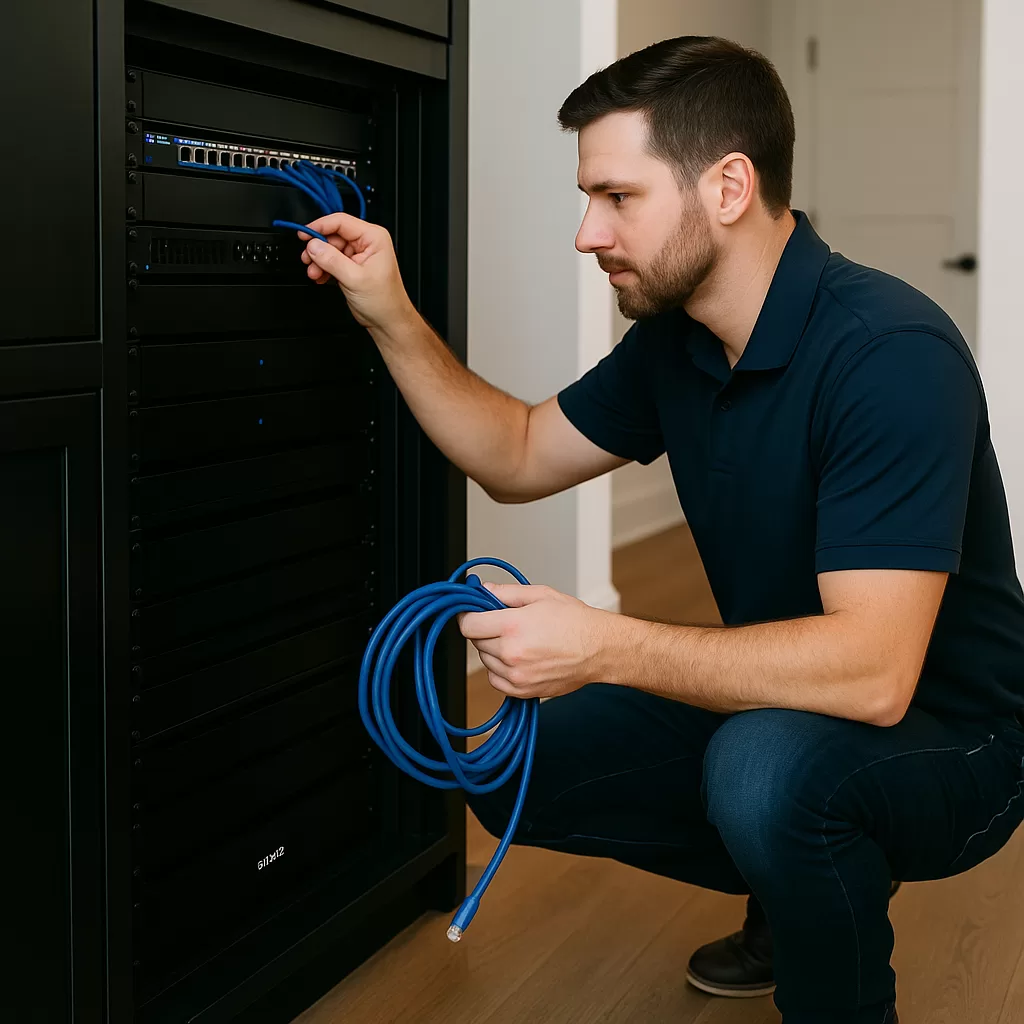A transparent and honest guide to understanding why pros avoid homeowner-supplied equipment.

You’ve just bought speakers, cameras, or networking gear online, and now you’re looking for a professional to come install it. But as you start calling around, you quickly realize: nobody seems willing to take the job.
So why is it so hard to find a professional to install the technology you’ve already purchased? Let’s break it down.
1. Accountability: Who’s Responsible When Something Doesn’t Work?
When a professional installs technology, they’re not just hanging speakers or running wires — they’re taking responsibility for the entire system working.
If a piece of homeowner-provided gear doesn’t function correctly, who’s at fault? The product? The wiring? The setup? With DIY brands, there often isn’t reliable manufacturer support either, which leaves both you and the installer stuck.
This is the number one reason many firms decline these types of projects. Without clear accountability, everyone ends up frustrated.
2. Business Reality: Why Established Firms Are More Selective
Every company has to balance what kinds of projects they can realistically take on. Smaller firms or one-person shops may be able to say yes to labor-only jobs more easily because they have less overhead to manage.
As companies grow, the dynamic changes. With more staff, trucks, and projects in motion, there’s a greater need for consistency in both labor and equipment to manage systems effectively and support clients long term. Larger firms can still provide highly personalized attention, but in order to do that well, they often need to be more selective about the types of projects they take on.
It’s not that labor-only projects aren’t valuable, it’s that established firms need to ensure they can stand behind every system they put their name on, and that requires a different business model.
3. Why We Don’t Recommend Every Brand You See Online
We don’t pick products because they’re trendy or cheap — we pick them because they actually work in real homes. Over the years, our process has boiled down to five things:
- Trial and Error: Products evolve, and sometimes what looks great on paper doesn’t hold up in practice. We’ve seen examples across categories — from TVs to outdoor speakers — where performance or warranty limitations forced us to rethink what we recommend. When a product consistently creates problems for clients, we stop using it and seek out a more reliable alternative.
- Sustainability: At the end of the day, we’re a business — and like any business, we have to make money to survive and keep serving our clients. Some DIY-focused products simply don’t offer the same margins as others, which makes them harder for professionals to build around. That doesn’t mean we never use them — Apple TV is a great example of a DIY product we and our clients really like, so we gladly recommend and support it. But when a product has slimmer margins and limited integration or weak dealer support, it just doesn’t add up for us or for our clients in the long run.
- Reliability: We only recommend products that don’t leave you calling every week for resets or replacements. If a specific product proves unreliable, we stop using it and move to something more dependable — even if we continue recommending other products from the same brand.
- Support: We work with brands that give us a direct dealer line, so we can get real solutions — not just the “factory reset” advice you’d get as a consumer. Strong manufacturer support helps us keep your system running long after installation.
- Integration: Our goal is for you to think of your home as a single system — not a collection of different systems in different rooms, each doing their own thing. But not every manufacturer prioritizes integration — and that’s okay. Take SONOS, for example. It’s the number one selling music system in the world, and part of the reason is that it works great inside its own app. SONOS has chosen to limit how deeply it integrates with certain control platforms, because they don’t want the potential of added support calls coming from outside their own ecosystem. That decision makes sense for them — SONOS is designed to be strong as a standalone solution. The same goes for products like Google Nest thermostats. They do certain “thermostat things” very well, and many homeowners are comfortable controlling them in their own app. By comparison, a control-platform thermostat (like Savant’s) may not offer every one of Nest’s features, but it doubles as a mini touchpanel that can run custom whole-home scenes — something Nest can’t do. It’s not about one product being “good” or “bad.” It’s about the experience you want. If you’re fine juggling multiple apps, Nest and SONOS can be great choices. But if your goal is simplicity — one system, one app, one point of accountability — then we recommend the products designed to deliver that unified experience.
Take SONY as an example of the flip side: fifteen years ago, we saw consistent HDMI input failures on their TVs. Today, those issues are long gone, and SONY is the brand we recommend because they control 4K from production to your living room. That kind of consistency is what gives us confidence to stand behind them.
The short version? We recommend what works, what lasts, and what we can actually stand behind — and we aren’t afraid to change course when real-world experience shows us we should.
4. Pricing: Fair and Transparent
Another reason homeowners try the “buy your own gear” approach is to save money. Nobody wants to pay inflated prices.
Here’s the truth: at Longwire, we sell products for the same price you’d pay online or at retail. We do this because it’s fair — and because if you could buy it cheaper somewhere else, you probably would.
The difference is this: when you purchase through us, you’re not just buying the product. You’re buying accountability. If something doesn’t work, we fix it. That’s not a promise you’ll get from an online checkout.
5. The Bottom Line
So, why is it so difficult to find a professional willing to install the gear you purchased yourself?
Because professional firms don’t just “install things” — they design, support, and stand behind complete systems. The challenge with homeowner-supplied gear isn’t that it’s automatically bad — plenty of people love products like SONOS or Ubiquiti. The issue is consistency. Every product has different settings, quirks, and support options, and some require far more troubleshooting than others.
For example, we know Access Networks delivers enterprise-level Wi-Fi that’s 99.99999999% reliable, which is why we recommend it — even though it costs more than Ubiquiti. That reliability means fewer late-night resets and fewer frustrated phone calls. The same goes for receivers, projectors, or security cameras: on the surface they might look the same, but how they configure, integrate, and perform day to day can be very different.
At Longwire, our goal is to be transparent and honest about why we make the recommendations we do. It isn’t about pushing a brand or adding extras you don’t need — it’s about protecting your investment, ensuring reliability, and giving you one trusted partner to call when you need help.
If you value reliability, peace of mind, and knowing your system will work the way you expect, the best choice is to work with a professional from the start. You’ll pay the same for the equipment, but you’ll gain something far more important: confidence that your home technology is built to last.
💡 Thinking about a new build or remodel? Even if you’re not sure what technology you’ll need, pre-wiring and system design today will save you headaches tomorrow. Contact us to start the conversation.
